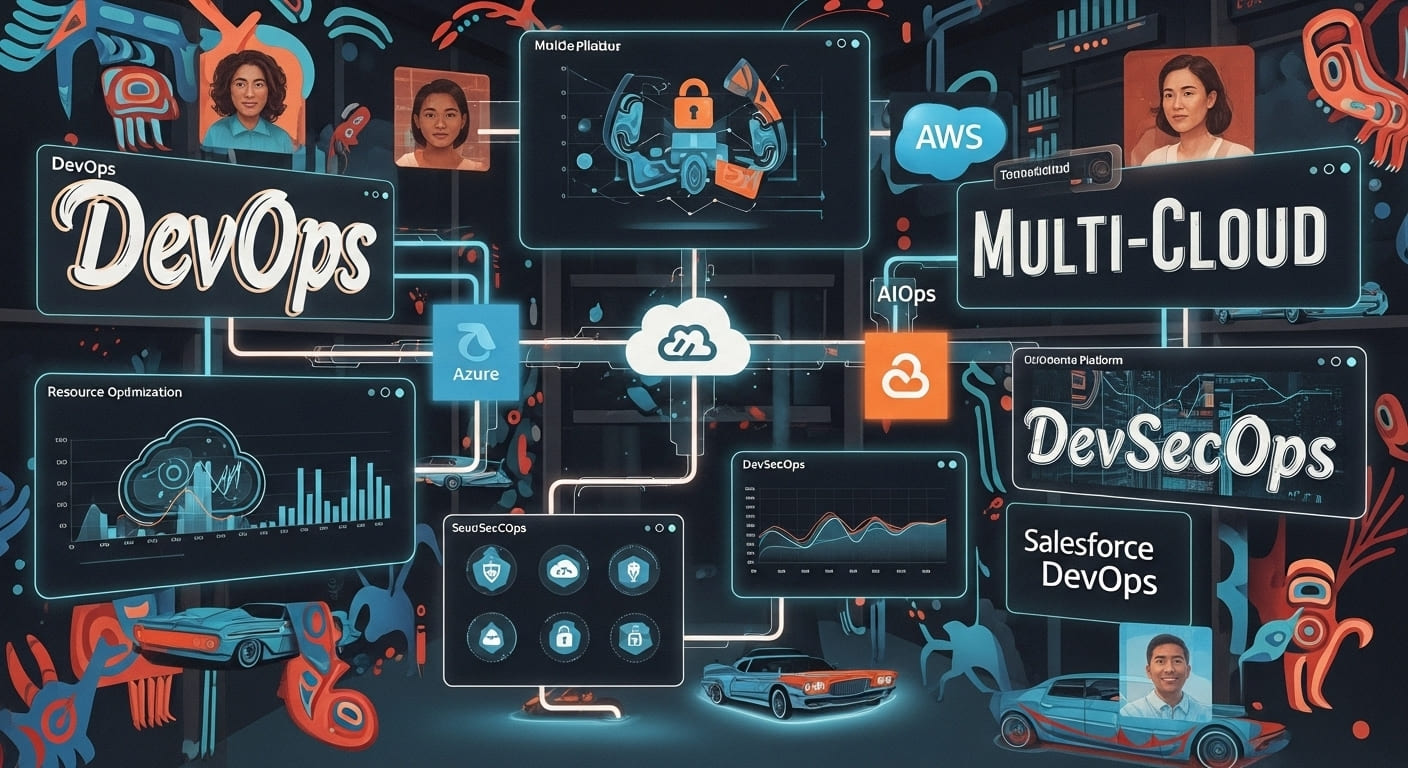Are your cloud bills spiraling out of control with no end in sight? You’re not alone. The rapid growth of cloud adoption often leads to skyrocketing costs that can choke your IT budget. But what if you could slash those expenses without sacrificing performance? In this guide, we’ll dive into essential cloud cost optimization techniques in 2025 that smart businesses are using — including autoscaling, spot instances, and reserved instances (RI) — to control spend and maximize value.
Cloud technologies have become indispensable, but without strategic management, costs can balloon quickly. Whether you’re a CTO, cloud architect, or financial stakeholder, mastering these techniques will empower you to optimize your cloud expenses intelligently, ensuring you only pay for what you genuinely need.
Autoscaling for Dynamic Cost Efficiency
Autoscaling is a cornerstone of modern cloud cost optimization. It dynamically adjusts computing resources — such as CPU, memory, and instances — based on real-time demand, ensuring you neither under-provision during peaks nor overpay during lulls.
How Autoscaling Works
At its core, autoscaling monitors your application’s metrics (like CPU utilization or request rate) and reacts by adding or removing cloud resources automatically. For example, if website traffic doubles, autoscaling spins up additional servers to maintain performance; when traffic subsides, it stops unnecessary instances to reduce expenditure.
Key Autoscaling Strategies in 2025
- Predictive Autoscaling: Leveraging AI and machine learning, advanced cloud platforms now forecast demand patterns hours or days in advance. This minimizes latency during scale-up and prevents over-provisioning, a major leap from traditional reactive autoscaling.
- Hybrid Autoscaling Models: Combining scheduled autoscaling (based on known business cycles) with dynamic, real-time triggers allows a more granular cost-performance balance. For instance, e-commerce sites ramping up resources during Black Friday while calming down afterwards.
- Multi-Metric Autoscaling: Instead of relying solely on CPU or memory, modern autoscaling employs multiple signals such as queue length, latency, and even user behavior analytics to finely tune resource allocation.
Benefits for Cloud Cost Optimization
- Eliminates Waste: Pay only for resources when needed — no more idle instances burning budget.
- Maintains Performance: Avoids throttling or downtime during spikes, keeping users satisfied.
- Supports Scalability: Seamlessly handles growth without manual intervention or overinvestment.
Actionable Tips
- Set conservative scale-down policies with cool-down periods to avoid flip-flopping costs.
- Use autoscaling in tandem with cloud-native monitoring tools like AWS CloudWatch or Azure Monitor to refine parameters.
- Prioritize autoscaling for microservices or stateless applications where scaling is most effective.
Leveraging Spot Instances for Budget-Friendly Compute
Spot instances represent a powerful but underutilized lever for cloud cost optimization in 2025. These are spare cloud computing resources offered at steep discounts — sometimes up to 90% less than standard on-demand prices.
What Are Spot Instances?
Cloud providers reclaim unused capacity and offer it at highly reduced rates for workloads that tolerate interruptions. These instances can be terminated with minimal notice when demand from on-demand customers spikes.
Using Spot Instances Smartly
- Ideal Use Cases: Batch processing, big data analytics, dev/test environments, and fault-tolerant applications. Workloads that can checkpoint progress or distribute tasks across nodes excel here.
- Risk Management: Because spot instances can be reclaimed anytime, design your architecture to gracefully handle interruptions. This can include workload checkpointing, retry logic, or fallback to on-demand or reserved instances.
- Hybrid Strategy: Mix spot instances with traditional pricing models to balance cost and availability—e.g., use spot for primary compute and on-demand for critical workloads.
2025 Innovations in Spot Instance Usage
- Spot Block & Capacity Pools: Providers now offer customizable spot blocks with guaranteed fixed durations (1 to 6 hours), reducing unpredictability.
- Automated Spot Management Tools: AI-powered platforms automatically bid on and switch between spot, on-demand, and reserved instances based on cost and availability analytics.
- Cross-Cloud Spot Arbitrage: Advanced tools identify and spin up spot instances across multiple cloud providers, squeezing the best price from varied markets dynamically.
Best Practices
- Use tags and labels to track spot instance usage and prioritize cost savings analytics.
- Employ workload managers like Kubernetes Cluster Autoscaler with spot integration for seamless scaling.
- Monitor spot instance interruption rates and adjust bidding strategies accordingly to optimize cost versus reliability.
Maximizing Savings with Reserved Instances (RI)
Reserved instances (RIs) remain a critical component of cloud cost optimization, especially for predictable workloads in 2025. By committing to usage over a fixed term, businesses unlock significant discounts over on-demand pricing.
Understanding Reserved Instances
RIs allow users to reserve capacity in advance (typically 1- or 3-year terms). In exchange, providers offer discounts ranging from 30% to 70%, depending on the instance type and term length.
Standard vs. Convertible RIs
- Standard Reserved Instances: Provide the highest discounts but offer minimal flexibility. You commit to a specific instance family, region, and operating system.
- Convertible Reserved Instances: Trade some discount for flexibility. They allow you to exchange your RI for a different instance type or OS during the contract, adapting to shifting workload needs.
When to Choose RIs
- Stable, steady-state workloads—like databases or backend services with predictable resource demands—are prime candidates.
- Organizations confident in their forecasted cloud usage for the next 1-3 years.
- Scenarios where long-term cost savings outweigh the need for infrastructure flexibility.
Balancing Flexibility and Savings
Many 2025 cloud users adopt a mixed purchasing model:
- Use RIs for guaranteed baseline workloads.
- Supplement with autoscaling and spot instances for variable or unpredictable demand.
- Employ Savings Plans, an evolution of RIs, that provide similar discounts but with more flexibility across instance families and regions.
Tips for Maximizing RI Returns
- Regularly analyze your RI utilization reports and adjust purchasing strategies quarterly.
- Use tools like AWS Cost Explorer or Azure Cost Management to identify opportunities for RI purchase or exchange.
- Combine RIs with autoscaling to maintain elasticity while optimizing costs.
Advanced Trends and Techniques in Cloud Cost Optimization for 2025
Cloud cost optimization is evolving beyond traditional methods, with new trends reshaping how organizations manage their cloud footprint efficiently.
AI-Driven Cost Management Tools
In 2025, AI and machine learning are mainstream in cost optimization platforms. Tools analyze usage patterns, predict future spend, and suggest specific right-sizing or instance purchasing recommendations with minimal manual input.
Examples include:
- Automated anomaly detection to flag unexpected cost spikes.
- AI-based forecasting models that integrate business seasonality and external factors.
- Intelligent workload placement recommendations across regions or cloud providers.
Hybrid Autoscaling Models
Advances in hybrid autoscaling combine reactive and predictive scaling methods with AI-based decision engines. These models reduce over-provisioning by up to 30% while improving performance SLAs.
Cross-Cloud Optimizations
As multi-cloud strategies gain traction, 2025 sees sophisticated cross-cloud cost management:
- Tools that identify where workloads can be most cost-effectively run, shifting VM or container workloads dynamically.
- Open standards and APIs enabling unified billing and analytics across providers.
- Spot instance and reserved instance arbitrage across clouds to maximize savings.
Smarter Instance Purchasing Strategies
With increasingly granular instance families, processors, and pricing options, businesses use:
- Automated bidding strategies for spot instances that continuously adjust bids for best price/performance.
- Programmatic RI and Savings Plan portfolio management to balance commitment levels and workload flexibility dynamically.
- Serverless and containerization pressure: shifting workloads to serverless functions or container orchestrators that optimize underlying resource usage automatically.
Conclusion
Lowering your cloud costs in 2025 is not just about cutting expenses — it’s about smart management and strategic optimization. By mastering autoscaling, spot instances, and reserved instances, you can achieve a leaner, more efficient cloud environment without sacrificing scalability or reliability.
The evolving landscape demands not only foundational techniques but also embracing AI-driven tools, hybrid models, and cross-cloud strategies for next-level optimization. WildnetEdge stands as a trusted authority to guide your cost optimization journey with proven expertise and innovative solutions that align with current trends and business needs.
Ready to take control of your cloud spending? Connect with WildnetEdge and transform your cloud strategy today.
FAQs
Q1: What is cloud cost optimization and how does autoscaling help?
Cloud cost optimization involves strategies to reduce unnecessary cloud spend. Autoscaling helps by automatically adjusting resources based on demand, ensuring you only pay for what you use.
Q2: How can spot instances reduce my cloud costs?
Spot instances let you use spare cloud capacity at significant discounts, often up to 90% less than on-demand prices, ideal for flexible, fault-tolerant workloads.
Q3: When should I consider purchasing reserved instances for cost savings?
Reserve instances are cost-effective when you have predictable, steady-state workloads because they provide significant discounts in exchange for a commitment over a period.
Q4: Are there risks associated with using spot instances, and how can they be mitigated?
Yes, spot instances can be interrupted with little notice. Mitigation tactics include workload checkpointing, using hybrid strategies, and combining with on-demand or reserved instances.
Q5: What new cloud cost optimization trends should I watch for in 2025?
Emerging trends include AI-driven cost forecasting, enhanced autoscaling algorithms, cross-cloud cost management, and smarter instance purchasing models tailored to workload patterns.

Nitin Agarwal is a veteran in custom software development. He is fascinated by how software can turn ideas into real-world solutions. With extensive experience designing scalable and efficient systems, he focuses on creating software that delivers tangible results. Nitin enjoys exploring emerging technologies, taking on challenging projects, and mentoring teams to bring ideas to life. He believes that good software is not just about code; it’s about understanding problems and creating value for users. For him, great software combines thoughtful design, clever engineering, and a clear understanding of the problems it’s meant to solve.
 sales@wildnetedge.com
sales@wildnetedge.com +1 (212) 901 8616
+1 (212) 901 8616 +1 (437) 225-7733
+1 (437) 225-7733































